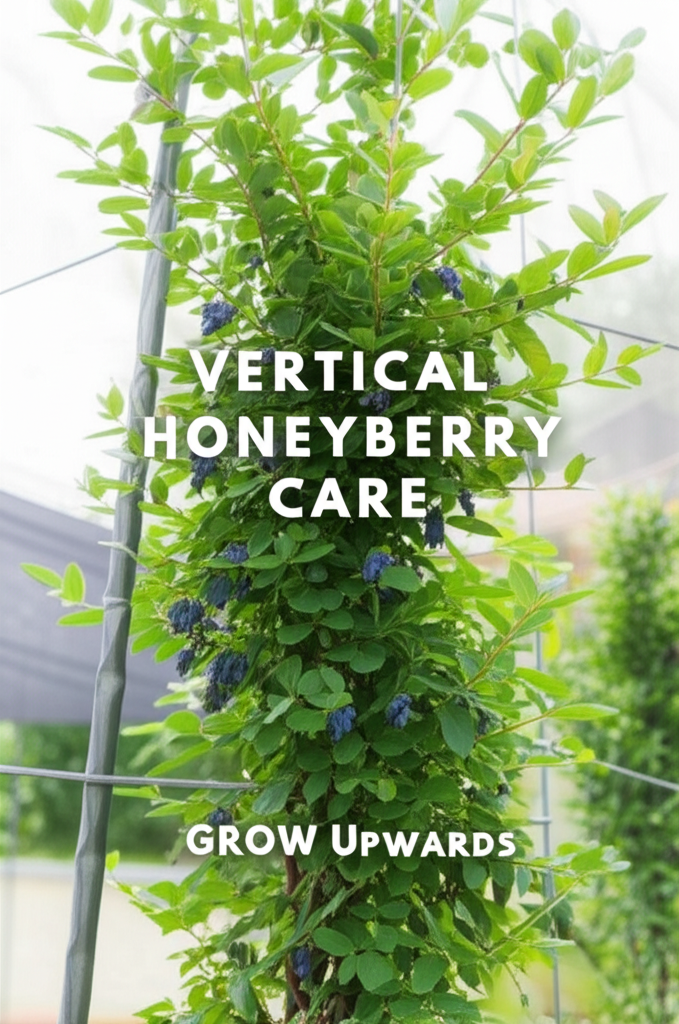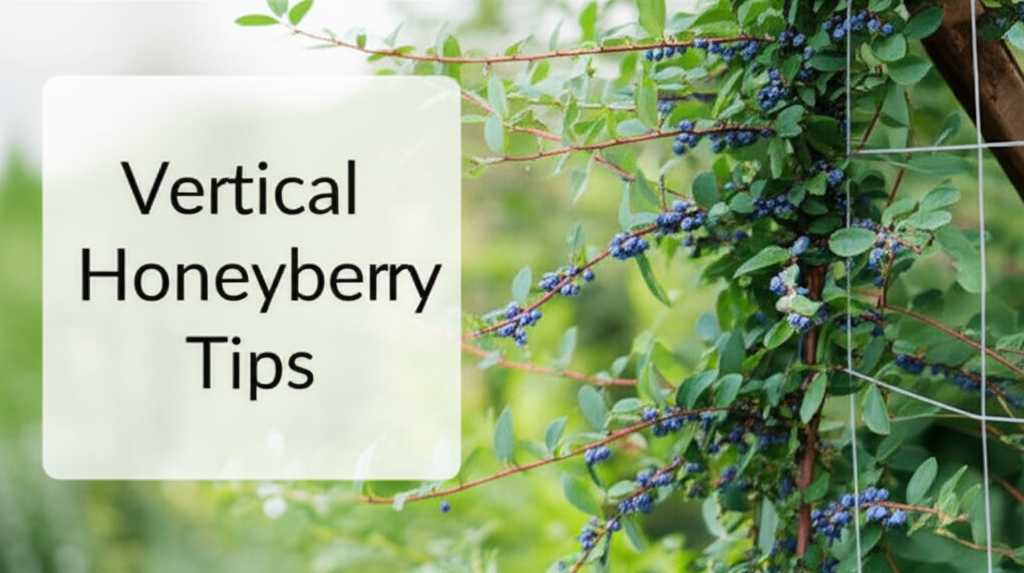Introduction to Vertical Honeyberry Gardening
Honeyberry shrubs (Lonicera caerulea), also known as Haskap, are increasingly popular for their delicious, antioxidant-rich berries and their hardiness. Traditionally grown as sprawling bushes, these versatile plants can be remarkably well-suited to vertical gardening techniques, offering a space-saving and efficient way to cultivate them, especially in smaller gardens or urban environments. Vertical gardening not only maximizes yield in a confined footprint but also enhances air circulation, reduces disease pressure, and can even make harvesting easier. This guide delves into the essential tips and considerations for successfully growing honeyberry shrubs vertically, transforming your garden space and bringing these nutritious berries within easy reach.
Why Choose Vertical Gardening for Honeyberries?

The benefits of adopting a vertical approach for your honeyberry cultivation are numerous. Beyond the obvious advantage of space efficiency, vertical systems promote better plant health and productivity.
Key Advantages of Vertical Honeyberry Cultivation
- Space Optimization: Ideal for small gardens, patios, balconies, or areas where horizontal space is limited.
- Improved Air Circulation: Elevating the plant canopy allows for better airflow, reducing the risk of fungal diseases and pest infestations.
- Enhanced Sunlight Exposure: Vertical structures can help ensure all parts of the plant receive adequate sunlight, leading to more uniform ripening and better fruit production.
- Easier Harvesting: With berries elevated, picking becomes less of a strain, particularly for those with mobility issues.
- Pest Deterrence: Keeping fruit off the ground can deter ground-dwelling pests like slugs and snails.
- Aesthetic Appeal: Well-designed vertical structures can add a unique and attractive architectural element to your garden.
Selecting the Right Honeyberry Varieties for Vertical Growth
Not all honeyberry varieties are created equal when it comes to vertical gardening. While the species itself is adaptable, certain cultivars are naturally more amenable to being trained upwards.
Characteristics to Look for in Vertical Honeyberry Varieties
- Compact Growth Habit: Varieties with a naturally more upright and less sprawling growth pattern are easier to train.
- Stronger Stems: Look for cultivars known for developing sturdy stems that can support the weight of fruit without collapsing.
- Pollination Partners: Remember that honeyberries require cross-pollination. Ensure you select at least two different varieties that bloom concurrently to maximize fruit set. This is even more critical in a vertical setup where plants are in closer proximity.
Recommended Varieties for Vertical Systems (Examples)
While specific recommendations can vary by region and availability, some varieties are generally considered good candidates for vertical training due to their growth habit. Always check local nursery recommendations.
| Variety Name | Typical Growth Habit | Notes for Vertical Gardening |
|---|---|---|
| ‘Aurora’ | Upright, moderately vigorous | Good structure, handles training well. |
| ‘Honey Bee’ | Upright to spreading, vigorous | Requires good support and pruning to maintain upright form. |
| ‘Tundra’ | Upright, dense | Forms a naturally sturdy bush, good for training. |
| ‘Berry Blue’ | Bushy, spreading | May require more careful management to keep vertical. |
Choosing and Building Vertical Support Structures
The success of your vertical honeyberry garden hinges on the quality and suitability of your support system. Several options are available, ranging from simple trellises to more elaborate structures.
Types of Vertical Support Systems
- Trellises: Simple, cost-effective, and versatile. Can be made from wood, metal, or sturdy wire mesh.
- Arbors and Pergolas: Offer more substantial support and can create a shaded walkway or seating area.
- Espalier Systems: Training plants against a flat surface or wire grid, ideal for creating a formal look.
- Obelisks and Cones: Decorative and functional, these structures allow plants to grow upwards and outwards.
- Wall-Mounted Systems: Attaching wire or mesh panels directly to a wall or fence.
DIY vs. Purchased Structures
- DIY: Offers customization and cost savings, allowing you to tailor the structure to your specific needs and aesthetic.
- Purchased: Convenient and often aesthetically pleasing, but can be more expensive.
Key Considerations When Building/Selecting Supports
- Height and Width: Determine the maximum height you can comfortably reach for harvesting and pruning. Consider the spread of mature plants.
- Sturdiness: The structure must be strong enough to support the weight of mature plants laden with fruit, as well as withstand wind and weather.
- Material Durability: Choose materials that are weather-resistant and won’t rot or rust quickly (e.g., treated wood, powder-coated metal, sturdy plastic mesh).
- Attachment Points: Ensure there are ample points to tie and guide the branches of the honeyberry shrub.
- Root Space: If using containers, ensure the support structure is stable and doesn’t compromise the container’s stability.
Planting and Training Honeyberries Vertically
The initial planting and subsequent training are crucial for establishing a successful vertical honeyberry system.
Planting Techniques
- Container Gardening: This is an excellent option for vertical systems. Choose large containers (at least 15-20 gallons) with good drainage. Use a well-draining potting mix. Place the support structure either within the container or attached to it before planting.
- In-Ground Planting: Dig a hole that is twice the width of the root ball and just as deep. Amend the soil with compost for improved drainage and fertility. Position the plant near your chosen support structure.
Initial Training Strategies
- Select a Strong Leader: Identify the most vigorous central stem and tie it loosely to the vertical support.
- Guide Lateral Branches: As new branches grow, gently tie them to the support structure, spacing them evenly. Aim to create an open, airy framework.
- Pruning for Shape: Early pruning is essential to establish the desired vertical form. Remove any branches that are growing inwards, crossing, or detracting from the upward growth.
Ongoing Care and Maintenance for Vertical Honeyberries
Once established, vertical honeyberry shrubs require consistent care to thrive.
Watering and Fertilization
- Watering: Vertical gardens, especially those in containers, can dry out more quickly. Water consistently, ensuring the soil is kept moist but not waterlogged. Deep watering is preferable to frequent shallow watering.
- Fertilization: Honeyberries are not heavy feeders. A balanced, slow-release fertilizer applied in early spring is usually sufficient. Over-fertilization can lead to excessive leafy growth at the expense of fruit production.
Pruning for Productivity and Shape
Pruning is arguably the most critical aspect of maintaining honeyberries in a vertical system. The goal is to encourage fruiting wood while maintaining the plant’s structure and accessibility.
Pruning Techniques
- Annual Pruning (Late Winter/Early Spring):
Remove any dead, damaged, or diseased branches.
Thin out crossing or rubbing branches.
Remove any branches growing inwards towards the center of the plant.
Aim to maintain an open structure that allows light and air to penetrate.
Prune suckers that emerge from the base of the plant.
- Summer Pruning (Optional):
To manage vigorous growth and maintain shape, you can pinch back or prune some of the longer, non-fruiting shoots. This redirects energy into fruit development and prevents the plant from becoming unruly.
- Fruiting Wood: Honeyberries fruit on spurs that develop on older wood, typically two-year-old and older branches. The goal of pruning is to balance the removal of older wood with the encouragement of new growth that will become next year’s fruiting wood.
Pest and Disease Management
Vertical gardening inherently improves air circulation, which helps in disease prevention. However, vigilance is still necessary.
Common Pests and Diseases
- Aphids: Can infest new growth. Encourage beneficial insects or use insecticidal soap if necessary.
- Birds: Honeyberries are a favorite of birds. Netting or other deterrents may be needed as the fruit ripens.
- Fungal Diseases: While less common in well-ventilated vertical systems, monitor for any signs of powdery mildew or leaf spot. Ensure proper spacing and avoid overhead watering late in the day.
Harvesting Honeyberries from a Vertical System
The ease of harvesting is one of the major benefits of vertical gardening, making the process more enjoyable and efficient.
Best Practices for Harvesting
- Timing: Honeyberries ripen from late spring to early summer, depending on the variety and your climate. The berries are ready when they are a deep blue-purple color and slightly soft to the touch.
- Gentle Handling: Honeyberries are delicate and can bruise easily. Harvest them by gently grasping the berry and twisting it slightly, or by clipping the stem.
- Accessibility: The elevated position of the berries in a vertical system means most of the fruit will be within easy reach, minimizing the need for ladders or bending.
- Collecting Fruit: Use shallow baskets or trays to collect the harvested berries to prevent crushing.
Troubleshooting Common Issues in Vertical Honeyberry Gardens
Even with the best planning, you might encounter a few challenges. Here are some common issues and how to address them.
Addressing Potential Problems
| Problem | Possible Cause | Solution |
|---|---|---|
| Poor Fruit Set | Lack of adequate pollination. | Ensure you have at least two compatible honeyberry varieties planted nearby. Check blooming times. |
| Weak Growth / Lack of Vigor | Insufficient sunlight, poor soil, or over-pruning. | Move container plants to a sunnier location, amend soil with compost, or adjust pruning strategy to retain more fruiting wood. |
| Branches Falling Over | Inadequate support or excessive fruit load on weak branches. | Reinforce the vertical support structure. Prune to balance the plant’s weight, removing overly heavy branches. |
| Yellowing Leaves | Nutrient deficiency or poor drainage. | Fertilize with a balanced fertilizer. If in a container, check drainage holes and consider repotting with fresh, well-draining soil. |
| Inconsistent Ripening | Uneven sunlight exposure or plant stress. | Prune to open up the canopy for better light penetration. Ensure consistent watering. |
Conclusion: The Future of Honeyberry Cultivation is Upward
Embracing vertical gardening for your honeyberry shrubs is a forward-thinking approach that maximizes space, enhances plant health, and simplifies harvesting. By selecting the right varieties, investing in a sturdy support system, and employing effective training and pruning techniques, you can transform even the most compact garden into a bountiful source of these delectable and nutritious berries. The journey from planting to harvest in a vertical honeyberry garden is rewarding, offering a unique blend of horticultural challenge and edible success. With a little planning and consistent care, your vertical honeyberry patch will become a striking and productive feature of your outdoor space for years to come.


